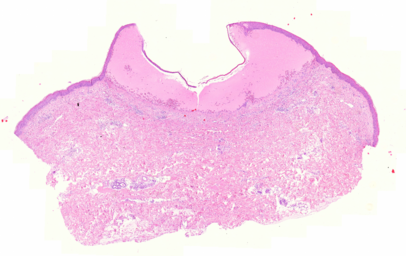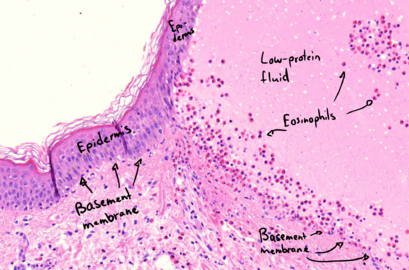47. Bullous pemphigoid: Difference between revisions
No edit summary |
No edit summary |
||
| Line 1: | Line 1: | ||
[[File:Bullous pemphigoid - overview.png|thumb|Overview| | [[File:Bullous pemphigoid - overview.png|thumb|Overview|406x406px]]'''Staining''': HE | ||
'''Organ''': Skin | '''Organ''': Skin | ||
| Line 7: | Line 7: | ||
Bullous pemphigoid is characterized by subepidermal nonancantholytic blisters. The main finding here is that the epidermis has been separated from the basement membrane it is usually attached to. This forms a bulla between the epidermis and the basement membrane. This bulla is filled with low-protein fluid and eosinophils. | Bullous pemphigoid is characterized by subepidermal nonancantholytic blisters. The main finding here is that the epidermis has been separated from the basement membrane it is usually attached to. This forms a bulla between the epidermis and the basement membrane. This bulla is filled with low-protein fluid and eosinophils. | ||
'''Diagnosis''': Bullous pemphigoid[[File:Bullous pemphigoid - high magnification.png|thumb|High magnification picture| | '''Diagnosis''': Bullous pemphigoid[[File:Bullous pemphigoid - high magnification.png|thumb|High magnification picture|409x409px]]'''Causes''': | ||
* Unknown | * Unknown | ||
Latest revision as of 14:53, 7 July 2024

Staining: HE
Organ: Skin
Description:
Bullous pemphigoid is characterized by subepidermal nonancantholytic blisters. The main finding here is that the epidermis has been separated from the basement membrane it is usually attached to. This forms a bulla between the epidermis and the basement membrane. This bulla is filled with low-protein fluid and eosinophils.
Diagnosis: Bullous pemphigoid

Causes:
- Unknown
Theory:
Blisters in bullous pemphigoid is triggered by linear deposition of autoreactive IgG antibodies and complement against the hemidesmosomes in the basement membrane. The hemidesmosomes have structural roles in dermoepidermal adhesion. This deposition causes the epidermis to detatch from the BM creating a fluid filled blister. The desmosomes however are spared in this autoimmune reaction, so the roof of the blister characteristically lacks acantholysis, and rather shows full thickness epidermis.
Bullous pemhpigoid and pemphgoid vulgaris share a similar pathogenic mechanism, but differ in clinical representation due to variation in the antigen targeted. Hemidesmosomes in bullous pemphigoid and desmosomes in pemhigus vulgaris.
